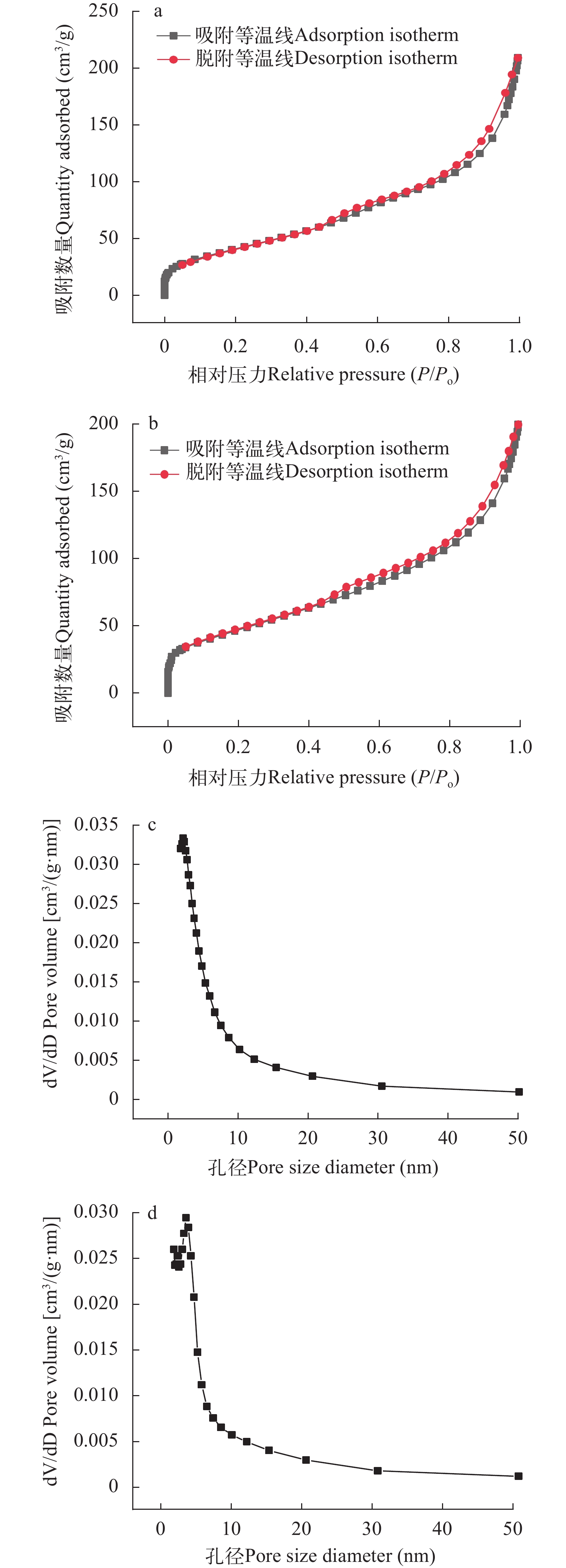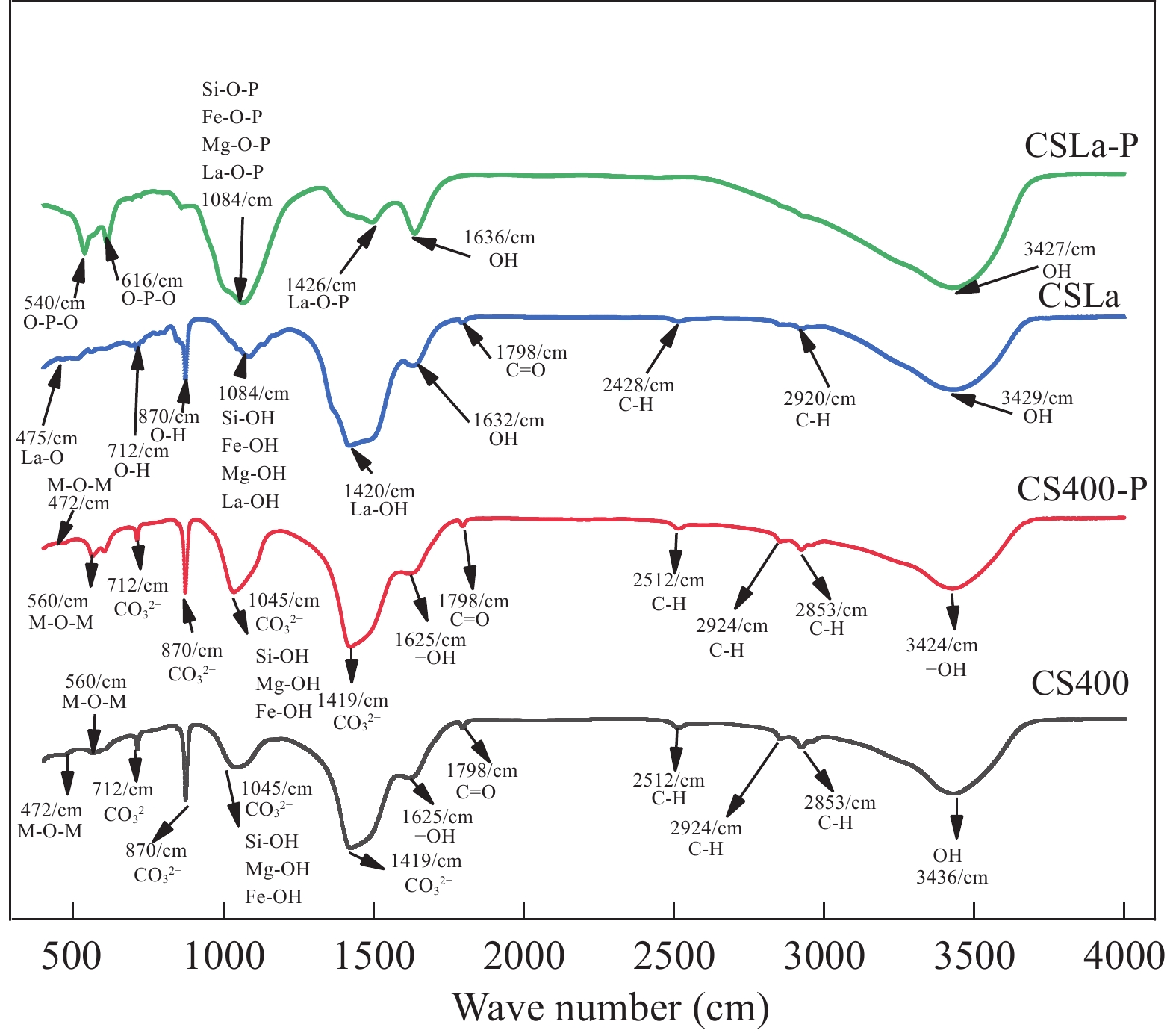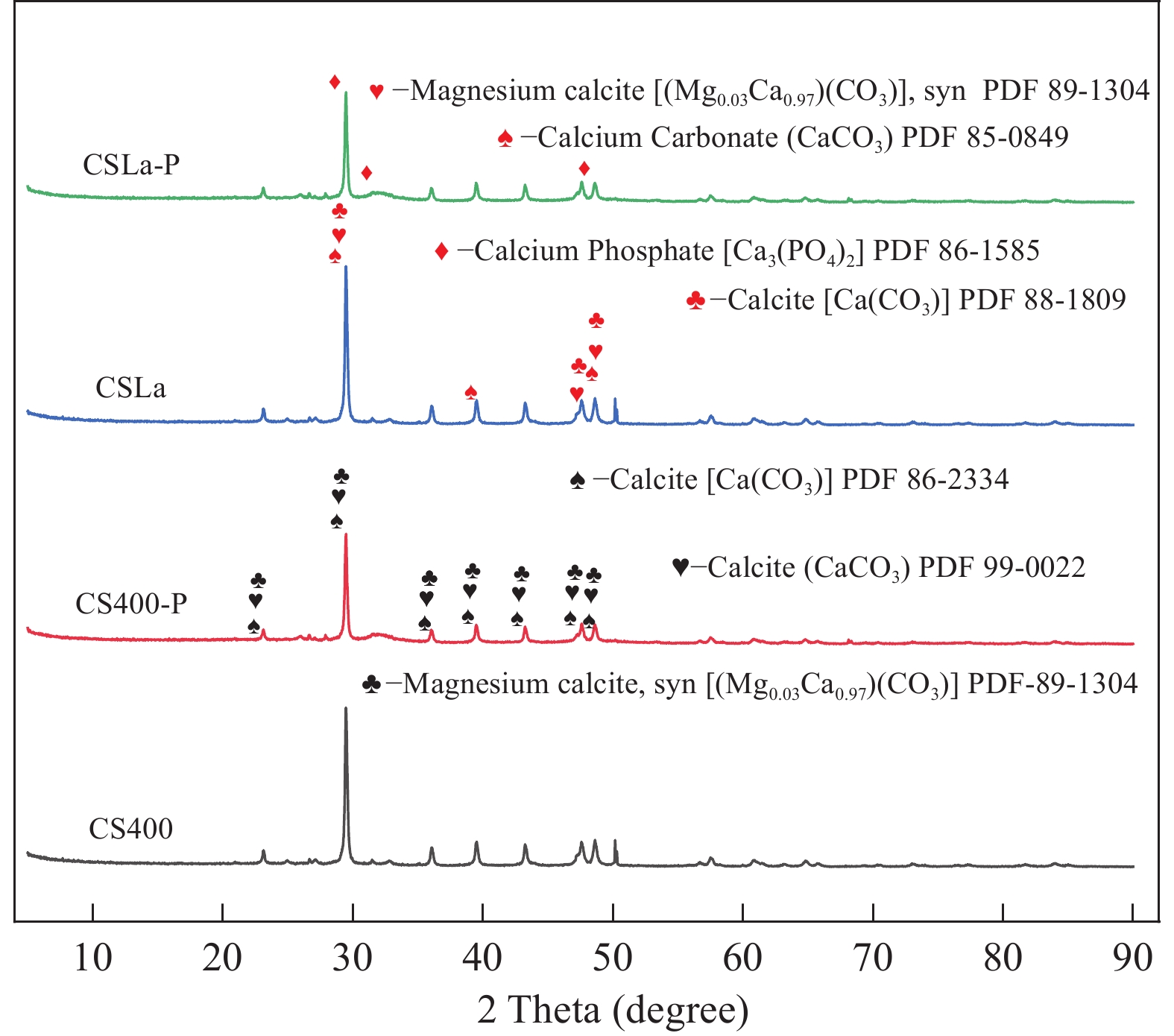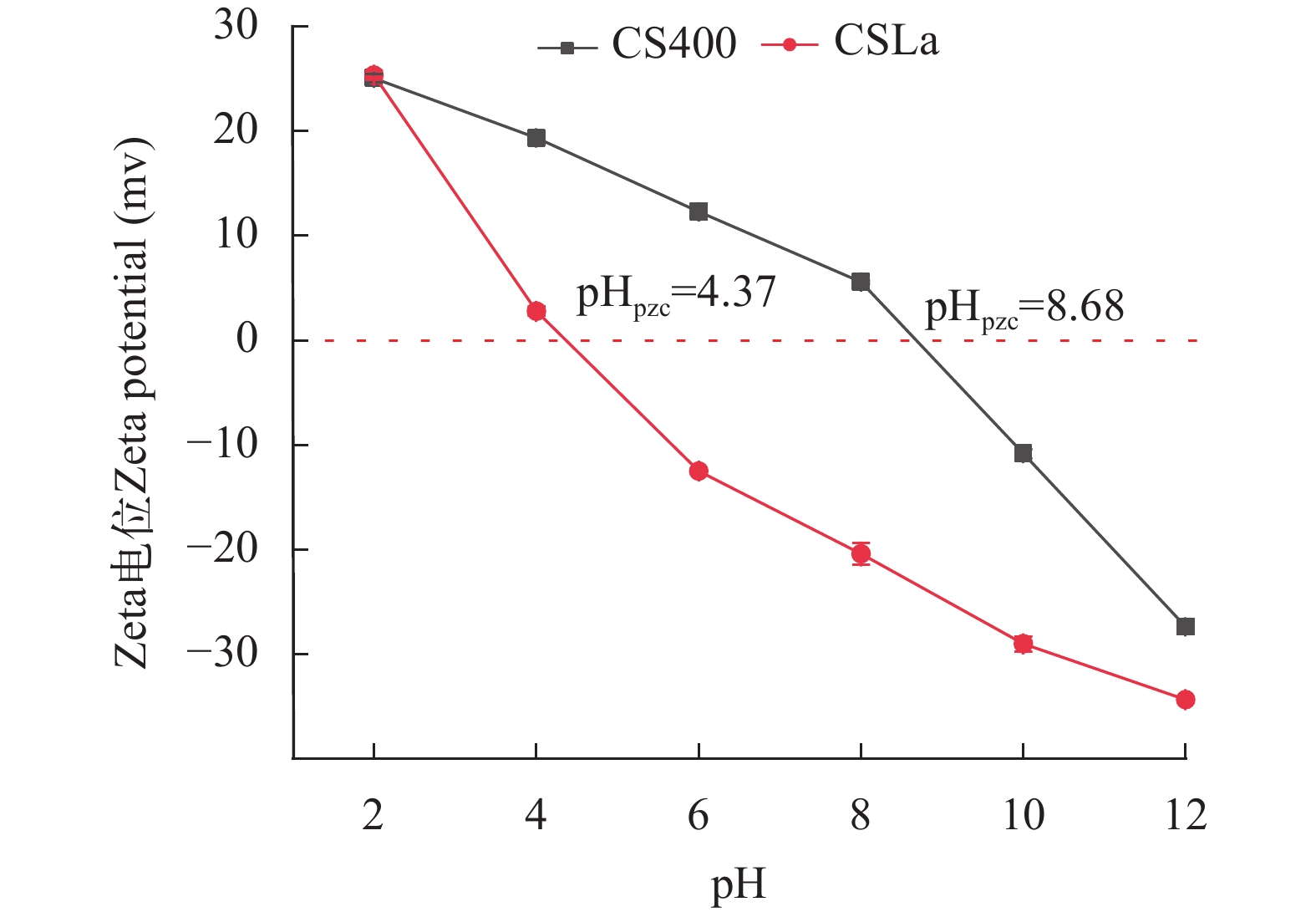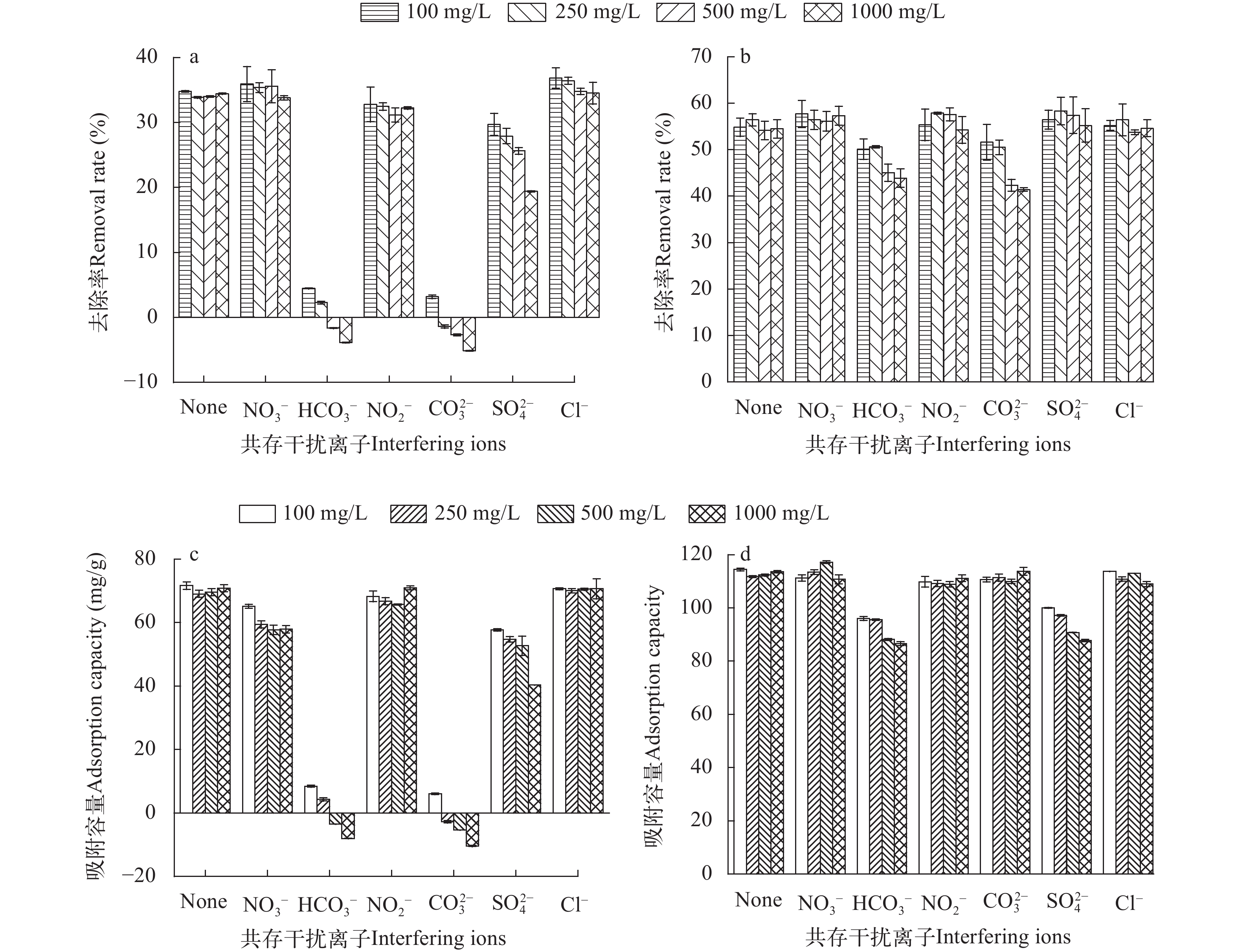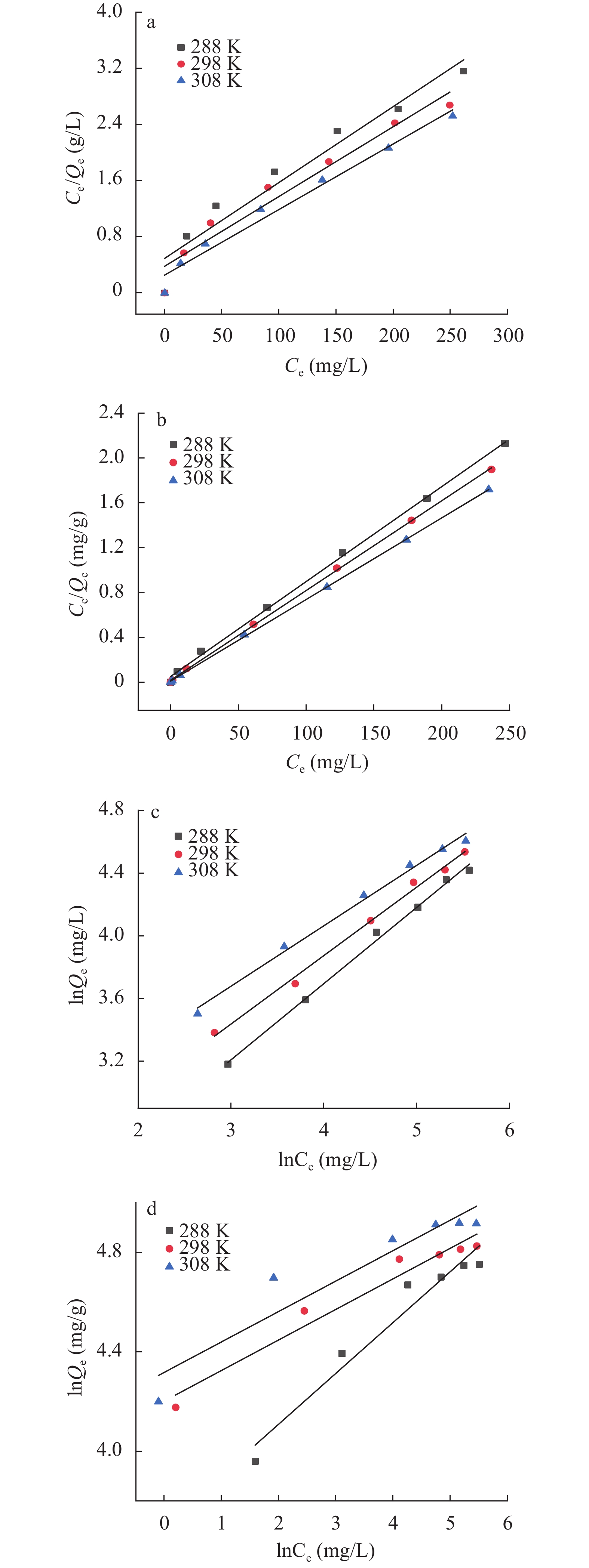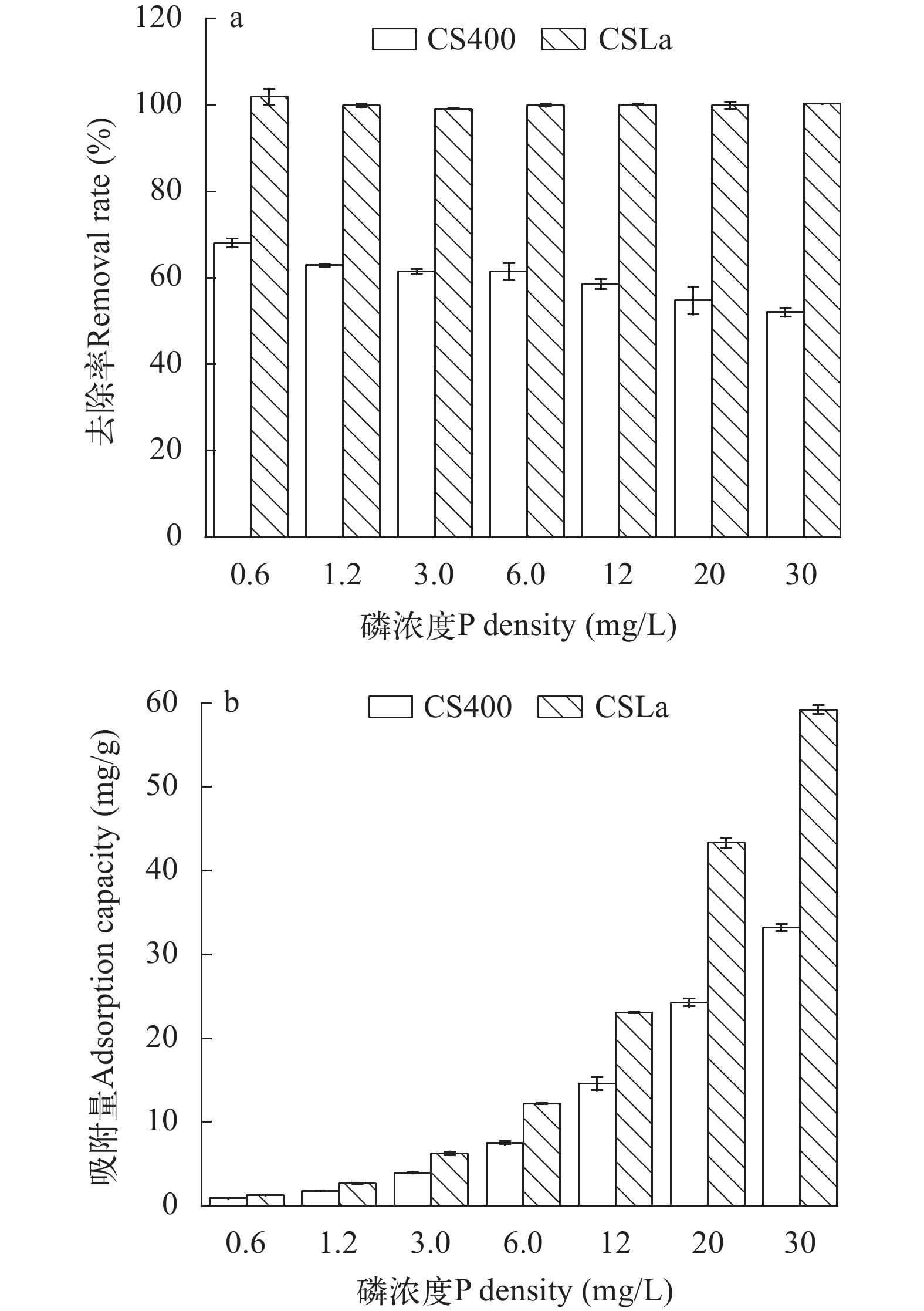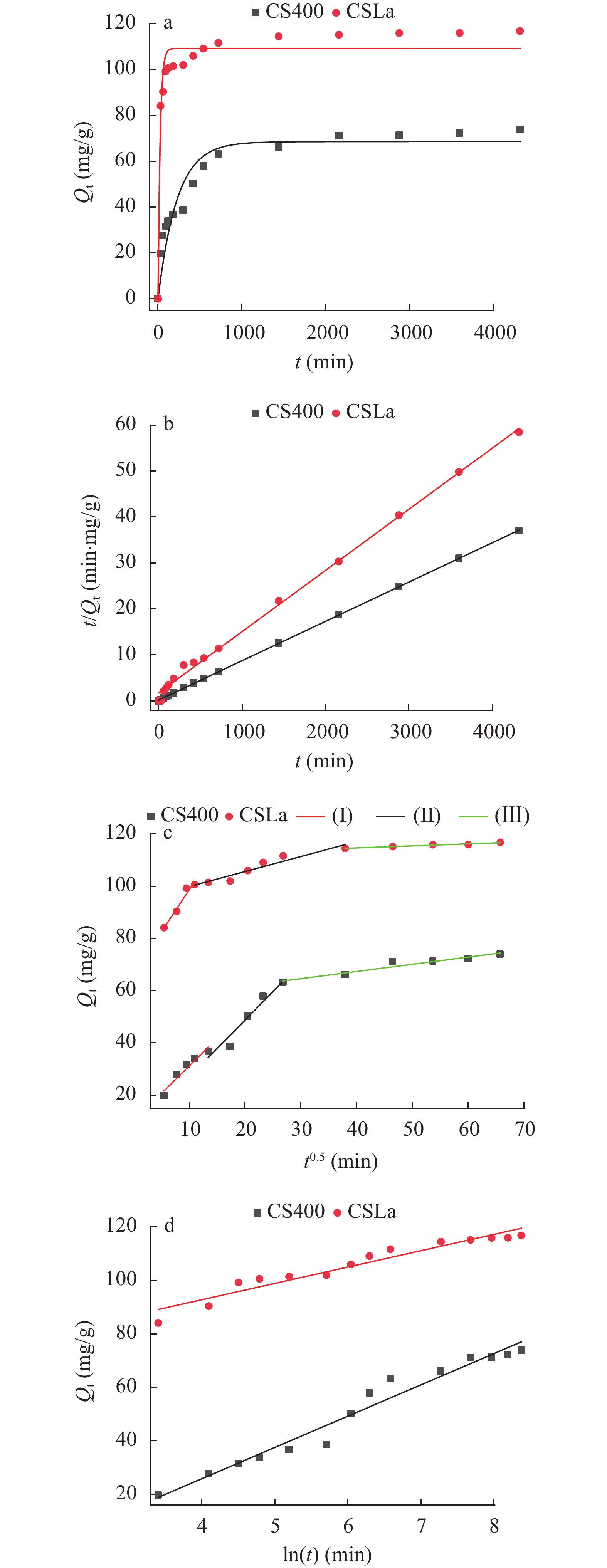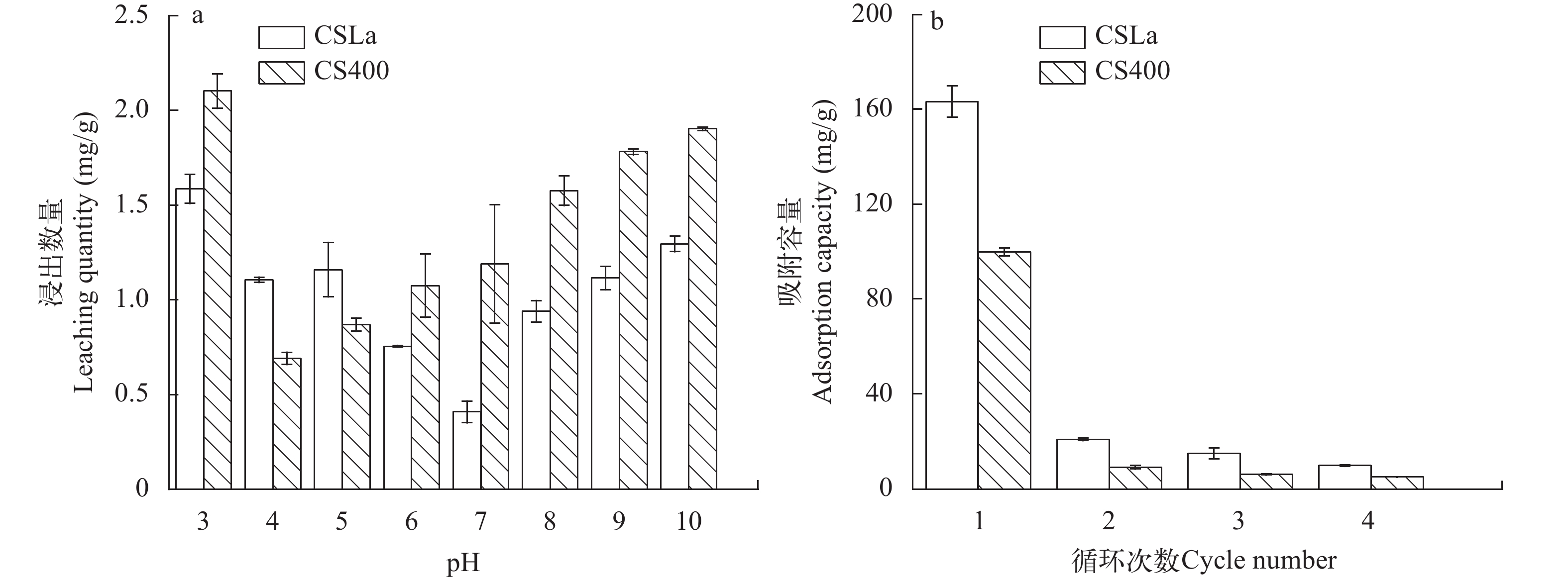PREPARATION OF BIOCHAR BY LOW TEMPERATURE PYROLYSIS OF LANTHANUM MODIFIED SHRIMP SHELLS FOR EFFICIENT PHOSPHORUS ADSORPTION
-
摘要:
为提高生物炭对磷的去除效果和将厨余废弃物的资源化利用, 文章以废弃虾壳为原料, 用NaOH将LaCl3以La(OH)3沉淀形式附着在虾壳表面, 进行热解得镧改性生物炭(CSLa)。采用XRF、SEM、BET、FTIR和XRD对改性前后的生物炭表征分析。采用吸附等温线模型和吸附动力学模型拟合生物炭的吸磷特征。研究了改性剂用量、初始pH、共存干扰离子对生物炭吸附磷的影响。结果表明镧化合物负载在生物炭表面, 对磷吸附能力明显提高, 最大理论吸附量为160.51 mg/g, 与CS400磷最大吸附量(100.60 mg/g)相比约提高60%。在低浓度或高浓度磷溶液条件下, CSLa对磷吸附量和去除率均高于CS400, 在实际水产养殖废水中更实用。吸附过程主要受化学吸附、颗粒内扩散控制。有关机理分析的结论表明表面沉淀作用、静电吸引、配体交换和内层络合作用是CSLa吸附磷的主要机理。CSLa更适合在弱酸性环境中除磷, 不过在碱性环境条件下其吸附量也比较高。
${\rm{HCO}}^-_3 $ 和${\rm{CO}}^{2-}_3 $ 对CSLa磷吸附有一定的抑制作用。研究以低温400℃为热解温度制备镧改性生物炭, 不仅提升了生物炭对磷的吸附量和去除率, 而且消耗热能较少, 更有利于实际应用。Abstract:In order to improve the phosphorus removal effect of biochar and resource utilization of food waste, we obtained lanthanum-modified biochar (CSLa) by using waste shrimp shells as raw material and attaching LaCl3 to the surface of shrimp shells in the form of La(OH)3 precipitation with NaOH by pyrolysis. The modified and unmodified biochar samples were characterized and analyzed by XRF, SEM, BET, FTIR and XRD. The adsorption kinetic and adsorption isotherm models were used to fit the phosphorus absorption characteristics of the biochar. The effects of modifier dosage, initial pH and coexisting interfering ions on phosphorus adsorption by biochar were investigated. The results showed that lanthanum modified shrimp shell biochar (CSLa) had abundant oxygen-containing functional groups on its surface. CSLa consisted mainly of La2O3, and its pore size distribution was dominated by mesoporous pores. The phosphorus adsorption process was better fitted with Langmuir isotherm, indicating the adsorption of phosphorus on CSLa was monolayer adsorption. The adsorption of phosphorus on CSLa was better described by quasi-secondary kinetics, indicating the phosphorus adsorption process by CSLa was chemisorption. The maximum theoretical adsorption capacity of CSLa was found to be 160.51 mg/g, achieved after 12h of adsorption. The adsorption and removal rates of phosphorus by CSLa were higher than those by CS400 at low or high phosphorus concentrations, which was more practical in real aquaculture tailwater. The adsorption rate of phosphorus on CSLa was mainly controlled by chemical adsorption and intraparticle diffusion. The mechanism analysis indicated that surface precipitation, electrostatic attraction, ligand exchange and internal complexation were the main mechanisms of phosphorus adsorption by CSLa. CSLa demonstrated better phosphorus removal performance under weakly acidic conditions, while the adsorption capacity was relatively high under alkaline environmental conditions. The interfering ions Cl–,
${\rm{NO}}^-_3 $ ,${\rm{NO}}^-_2 $ and${\rm{SO}}^{2-}_4 $ had no effect on CSLa phosphorus adsorption, while${\rm{HCO}}^-_3 $ and${\rm{CO}}^{2-}_3 $ had some inhibitory effect on CS400 phosphorus adsorption. In this study, lanthanum-modified biochar was prepared at a low temperature of 400℃ as the pyrolysis temperature, which not only enhanced the adsorption and removal rate of phosphorus by biochar, but also consumed less thermal energy, which was more beneficial to practical applications.-
Keywords:
- Shrimp shell biochar /
- Phosphate adsorption /
- Lanthanum modification
-
-
表 1 CS400和CSLa的X荧光光谱
Table 1 X-fluorescence spectrum of CS400 and CSLa
组分
Component含量
Content (%)组分
Component含量
Content (%)CS400 CSLa CS400 CSLa La2O3 0.07 76.92 K2O 0.46 0.03 CaO 86.33 16.72 SrO 0.41 0.03 P2O5 5.74 1.28 TiO2 0.08 0.02 SiO2 2.28 0.41 ZnO 0.04 0.02 MgO 1.35 0.15 CuO 0.04 0.02 Fe2O3 0.82 0.25 ZrO2 0.02 / SO3 0.77 0.20 Cr2O3 0.01 / MnO 0.59 0.11 WO3 0.01 / Cl 0.51 2.85 NiO 0.01 0.01 Na2O / 0.40 PbO / 0.02 Al2O3 / 0.19 Tb4O7 / 0.07 Cs2O / 0.11 SrO / 0.03 CeO2 / 0.11 V2O5 / 0.03 表 2 生物炭的BET参数
Table 2 BET parameter of biochar
样品Sample 表面积Specific area (m2/g) 体积Volume (cm3/g) 平均孔径Average pore diameter (nm) CS400 170.06 0.31 7.26 CSLa 151.86 0.30 8.03 表 3 CS400和CSLA吸附等温线模型参数
Table 3 Adsorption isotherm model parameters by CS400 and CSLA
项目Item Langmuir model Freundlich model Temperature (K) k1 (L/mg) Qm (mg/g) R2 kf (L/mg) n R2 CS400 288 0.02 92.51 0.9412 1.75 0.49 0.9957 298 0.04 107.07 0.9505 2.13 0.44 0.9950 308 0.03 100.60 0.9771 2.52 0.39 0.9929 CSLa 288 0.16 118.06 0.9987 4.89 0.02 0.9520 298 0.17 144.30 0.9947 6.68 0.02 0.9932 308 0.26 160.51 0.9967 6.80 0.01 0.9235 表 4 CS400和CSLa吸附磷酸盐的动力学模型参数
Table 4 Kinetic parameters of phosphorus adsorption by CS400 and CSLa
Pseudo first-order model Pseudo-second-order model k1 (/min) Qm (mg/g) R2 k2 (min) Qm [g(mg·
min)]R2 CS400 0.0044 68.55 0.9079 0.0001 75.19 0.9971 CSLa 0.0396 109.20 0.9503 0.0003 116.96 0.9999 Elovich Intraparticle diffusivity (Ⅰ) α [mg/
(g·min)]β (mg/g) R2 kw1 (/min) b R2 CS400 1.96 0.09 0.9645 2.17 10.07 0.9388 CSLa 445631.56 0.16 0.9325 0.08 111.56 0.9589 Intraparticle diffusivity (Ⅱ) Intraparticle diffusivity (Ⅲ) kw2 (/min) b R2 kw3 (/min) b R2 CS400 2.18 5.15 0.9461 0.28 56.32 0.9334 CSLa 0.28 56.32 0.9334 0.26 42.64 0.8991 -
[1] 沈建筑, 李潇轩, 李志辉, 等. 浅析淡水养殖尾水处理技术及达标排放措施 [J]. 水产养殖, 2019, 40(5): 37-39. doi: 10.3969/j.issn.1004-2091.2019.05.014 Shen J Z, Li X X, Li Z H, et al. Analysis of freshwater aquaculture tailwater treatment technology and measures to meet the standard discharge [J]. Journal of Aquaculture, 2019, 40(5): 37-39. doi: 10.3969/j.issn.1004-2091.2019.05.014
[2] 陶玲, 彭格格, 陈思媛, 等. 稻田湿地循环利用池塘养殖尾水效果 [J]. 水生生物学报, 2022, 46(10): 1466-1474. doi: 10.7541/2022.2022.0178 Tao L, Peng G G, Chen S Y, et al. Effect of recycling fishpond wastewater in paddy wetland [J]. Acta Hydrobiologica Sinica, 2022, 46(10): 1466-1474. doi: 10.7541/2022.2022.0178
[3] 曹涛涛, 徐栋, 白国梁, 等. 以RAS固体废弃物为碳源的改进型人工湿地对养殖尾水的脱氮效果 [J]. 水生生物学报, 2022, 46(10): 1475-1483、1591. doi: 10.7541/2023.2022.0190 Cao T T, Xu D, Bai G L, et al. Nitrogen removal effect of aquaculture water through improved constructed wetland using recirculating aquaculture system solid waste as carbon source [J]. Acta Hydrobiologica Sinica, 2022, 46(10): 1475-1483、1591. doi: 10.7541/2023.2022.0190
[4] Genz A, Kornmüller A, Jekel M. Advanced phosphorus removal from membrane filtrates by adsorption on activated aluminium oxide and granulated ferric hydroxide [J]. Water Research, 2004, 38(16): 3523-3530. doi: 10.1016/j.watres.2004.06.006
[5] Desmidt E, Ghyselbrecht K, Zhang Y, et al. Global phosphorus scarcity and full-scale P-recovery techniques: a review [J]. Critical Reviews in Environmental Science and Technology, 2015, 45(4): 336-384. doi: 10.1080/10643389.2013.866531
[6] Cordell D, Rosemarin A, Schröder J J, et al. Towards global phosphorus security: A systems framework for phosphorus recovery and reuse options [J]. Chemosphere, 2011, 84(6): 747-758. doi: 10.1016/j.chemosphere.2011.02.032
[7] Almanassra I W, Mckay G, Kochkodan V, et al. A state of the art review on phosphate removal from water by biochars [J]. Chemical Engineering Journal, 2021(409): 128211. doi: 10.1016/j.cej.2020.128211
[8] Wu B L, Wan J, Zhang Y Y, et al. Selective phosphate removal from water and wastewater using sorption: process fundamentals and removal mechanisms [J]. Environmental Science & Technology, 2020, 54(1): 50-66.
[9] Chen H B, Gao Y R, Li J H, et al. Engineered biochar for environmental decontamination in aquatic and soil systems: a review [J]. Carbon Research, 2022, 1(1): 1-12. doi: 10.1007/s44246-022-00001-9
[10] Yao Y, Gao B, Chen J J, et al. Engineered biochar reclaiming phosphate from aqueous solutions: mechanisms and potential application as a slow-release fertilizer [J]. Environmental Science & Technology, 2013, 47(15): 8700-8708.
[11] Sornhiran N, Aramrak S, Prakongkep N, et al. Silicate minerals control the potential uses of phosphorus-laden mineral-engineered biochar as phosphorus fertilizers [J]. Biochar, 2022, 4(1): 14-30. doi: 10.1007/s42773-022-00143-4
[12] 廖太万. 含镧化合物改性除磷吸附剂的制备及吸附性能研究 [D]. 广州: 暨南大学, 2019: 19-56. Liao T W. Preparation of lanthanum compound modified adsorbents and studies of their phosphate removal performances [D]. Guangzhou: Jinan University, 2019: 19-56.
[13] 赵莎莎. 镧改性稻壳炭对磷吸附性能研究 [D]. 重庆: 西南大学, 2021: 13-14. Zhao S S. Adsorption performance of phosphate by lanthanum modified rice husk char [D]. Chongqing: Southwest University, 2021: 13-14.
[14] 罗元, 谢坤, 冯弋洋, 等. 镧改性核桃壳生物炭制备及吸附水体磷酸盐性能 [J]. 化工进展, 2021, 40(2): 1121-1129. doi: 10.16085/j.issn.1000-6613.2020-0753 Luo Y, Xie K, Feng G Y, et al. Preparation of lanthanum modified walnut shell biochar and adsorption of phosphate from aqueous solutions [J]. Chemical Industry and Engineering Progress, 2021, 40(2): 1121-1129. doi: 10.16085/j.issn.1000-6613.2020-0753
[15] Wang W W, Zhu S J, Li N H, et al. Enhanced Cd2+ adsorption and toxicity for microbial biofilms in the presence of TiO2 nanoparticles [J]. Environmental Pollution, 2022(314): 120239. doi: 10.1016/j.envpol.2022.120239
[16] Shimizu T, De S K K, Hara M, et al. Facile synthesis of carbon nanotubes and cellulose nanofiber incorporated graphene aerogels for selective organic dye adsorption [J]. Applied Surface Science, 2022(600): 154098. doi: 10.1016/j.apsusc.2022.154098
[17] Mahyoob W, Alakayleh Z, Abu H H A, et al. A novel co-processed olive tree leaves biomass for lead adsorption from contaminated water [J]. Journal of Contaminant Hydrology, 2022(248): 104025. doi: 10.1016/j.jconhyd.2022.104025
[18] Wang J X, Liu P, Huang H J, et al. Pyrolysis of different sewage sludge feedstocks for biochar products: Characterization and application [J]. Journal of Central South University, 2020, 27(11): 3302-3319. doi: 10.1007/s11771-020-4548-y
[19] Diaz D T J L, Silva A M T, Faria J L, et al. Removal of Sudan IV from a simulated biphasic oily wastewater by using lipophilic carbon adsorbents [J]. Chemical Engineering Journal, 2018(347): 963-971. doi: 10.1016/j.cej.2018.04.105
[20] Taffarel S R, Rubio J. On the removal of Mn2+ ions by adsorption onto natural and activated Chilean zeolites [J]. Minerals Engineering, 2009, 22(4): 336-343. doi: 10.1016/j.mineng.2008.09.007
[21] Ho Y S, Mckay G. Pseudo-second order model for sorption processes [J]. Process Biochemistry, 1999, 34(5): 451-465. doi: 10.1016/S0032-9592(98)00112-5
[22] 徐沁媛. 湿地植物载镧生物炭La-CB对磷酸盐的吸附性能研究 [D]. 重庆: 重庆大学, 2019: 33-34. Xu X Y. Study on phosphate adsorption by lanthanum doped wetland plants biochars (La-CB) [D]. Chongqing: Chongqing University, 2019: 33-34.
[23] Koilraj P, Sasaki K. Selective removal of phosphate using La-porous carbon composites from aqueous solutions: Batch and column studies [J]. Chemical Engineering Journal, 2017(317): 1059-1068. doi: 10.1016/j.cej.2017.02.075
[24] Kong L C, Tian Y, Li N, et al. Highly-effective phosphate removal from aqueous solutions by calcined nano-porous palygorskite matrix with embedded lanthanum hydroxide [J]. Applied Clay Science, 2018(162): 507-517. doi: 10.1016/j.clay.2018.07.005
[25] Zhang L, Zhou Q, Liu J Y, et al. Phosphate adsorption on lanthanum hydroxide-doped activated carbon fiber [J]. Chemical Engineering Journal, 2012(185-186): 160-167. doi: 10.1016/j.cej.2012.01.066
[26] Wang Z H, Guo H Y, Shen F, et al. Biochar produced from oak sawdust by Lanthanum (La)-involved pyrolysis for adsorption of ammonium (
${\rm{NH}}^{+}_4 $ ), nitrate (${\rm{NO}}^-_3 $ ), and phosphate (${\rm{PO}}^{3-}_4 $ ) [J]. Chemosphere, 2015(119): 646-653. doi: 10.1016/j.chemosphere.2014.07.084[27] Peng G F, Jiang S Q, Wang Y X, et al. Synthesis of Mn/Al double oxygen biochar from dewatered sludge for enhancing phosphate removal [J]. Journal of Cleaner Production, 2020(251): 119725. doi: 10.1016/j.jclepro.2019.119725
[28] Chen B L, Chen Z M, Lv S F. A novel magnetic biochar efficiently sorbs organic pollutants and phosphate [J]. Bioresource Technology, 2011, 102(2): 716-723. doi: 10.1016/j.biortech.2010.08.067
[29] Yin X J, Li X, Petropoulos E, et al. Phosphate removal from actual wastewater via La(OH)3-C3N4 adsorption: Performance, mechanisms and applicability [J]. science of the Total Environment, 2022(814): 152791. doi: 10.1016/j.scitotenv.2021.152791
[30] 戴田池. 改性秸秆生物炭吸附水中磷酸盐和四环素效能及机理研究 [D]. 哈尔滨: 哈尔滨工业大学, 2021: 41-42. Dai T C. The adsorption efficiency and mechanism of phosphate and tetracyline in water by modified straw biochar [D]. Haerbin: Harbin Institute of Technology, 2021: 41-42.
[31] Yin H B, Kong M, Fan C X. Batch investigations on P immobilization from wastewaters and sediment using natural calcium rich sepiolite as a reactive material [J]. Water Research, 2013, 47(13): 4247-4258. doi: 10.1016/j.watres.2013.04.044
[32] Wang Z H, Shen D K, Shen F, et al. Phosphate adsorption on lanthanum loaded biochar [J]. Chemosphere, 2016(150): 1-7. doi: 10.1016/j.chemosphere.2016.02.004
[33] Huang W Y, Li D, Liu Z Q, et al. Kinetics, isotherm, thermodynamic, and adsorption mechanism studies of La(OH)3-modified exfoliated vermiculites as highly efficient phosphate adsorbents [J]. Chemical Engineering Journal, 2014(236): 191-201. doi: 10.1016/j.cej.2013.09.077
[34] Mondal S, Majumder S K. Honeycomb-like porous activated carbon for efficient copper (Ⅱ) adsorption synthesized from natural source: Kinetic study and equilibrium isotherm analysis [J]. Journal of Environmental Chemical Engineering, 2019, 7(4): 103236. doi: 10.1016/j.jece.2019.103236
[35] Wu B L, Fang L P, Fortner J D, et al. Highly efficient and selective phosphate removal from wastewater by magnetically recoverable La(OH)3/Fe3O4 nanocomposites [J]. Water Research, 2017(126): 179-188. doi: 10.1016/j.watres.2017.09.034
[36] Xie S F, Han X G, Kuang Q, et al. Intense and wavelength-tunable photoluminescence from surface functionalized MgO nanocrystal clusters [J]. Journal of Materials Chemistry, 2011, 21(20): 7263-7268. doi: 10.1039/c1jm10745c










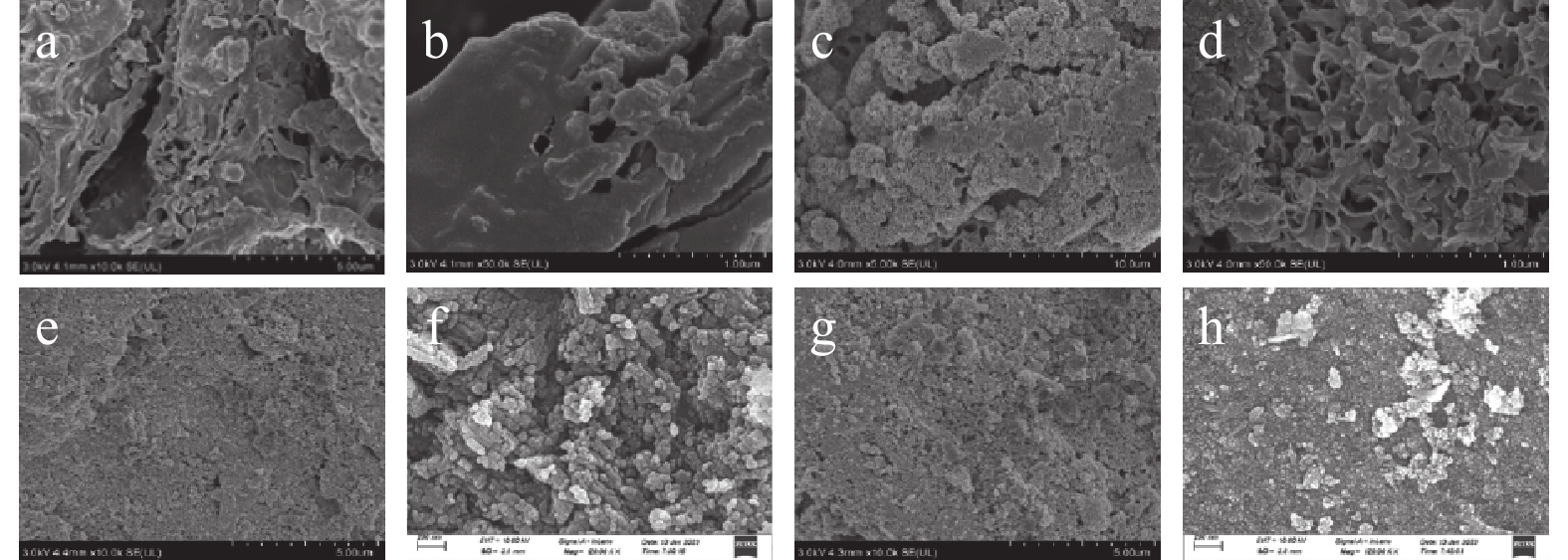
 下载:
下载:
